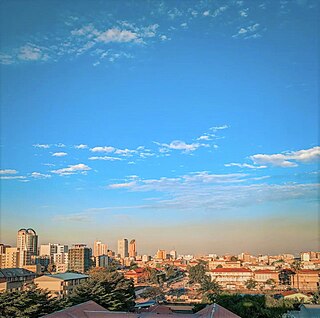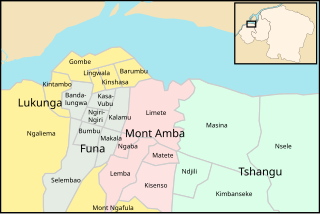
Kinshasa, formerly named Léopoldville until 30 June 1966, is the capital and largest city of the Democratic Republic of the Congo. Kinshasa is one of the world's fastest-growing megacities, with an estimated population, in 2024, of 17,032,322. It is the most densely populated city in the DRC, the most populous city in Africa, the world's fourth-most-populous capital city, Africa's third-largest metropolitan area, and the leading economic, political, and cultural center of the DRC. Kinshasa houses several industries, including manufacturing, telecommunications, banking, and entertainment. The city also hosts some of DRC's significant institutional buildings, such as the People's Palace, Palace of the Nation, Court of Cassation, Constitutional Court, African Union City, Marble Palace, Martyrs Stadium, Government House, Kinshasa Financial Center, and other national departments and agencies.

Goma is the capital and largest city of the North Kivu Province in the eastern region of the Democratic Republic of the Congo. It is located on the northern shore of Lake Kivu and shares borders with Bukumu Chiefdom to the north, Rwanda to the east and Masisi Territory to the west. The city lies in the Albertine Rift, the western branch of the East African Rift, and is only 13–18 km (8.1–11.2 mi) south of the active volcano Mount Nyiragongo. With an approximate area of 75.72 km2 (29.24 sq mi), the city has an estimated population of nearly 2 million people according to the 2022 census.
Mbuyamu Ilankir "Freddy" Matungulu (born January 4, 1955 Belgian Congo is a Congolese economist. He was Minister of Finance of the Democratic Republic of the Congo from 2001 to 2003.

Bandalungwa is a commune in the Funa District of Kinshasa in the western region of the Democratic Republic of the Congo. Covering an area of 6.82 square kilometers, Bandalungwa is centrally situated within the city. It is bordered by the Gombe commune and the Kokolo military barracks to the north, Selembao to the south, the communes of Ngiri-Ngiri, Kasa-Vubu, and Lingwala to the east, and the Makelele River, Ngaliema, and Kintambo to the west. The commune had an estimated population of 934,821 in 2015, although official census data from 2016 reported a significantly lower figure of 259,760 residents.

Barumbu is a commune in the Lukunga District of Kinshasa, located strategically in the northern region of the city. As of 2015, Barumbu had an estimated population of 413,628, making it one of Kinshasa's more densely populated communes.

Gombe, also known as La Gombe, or Downtown Kinshasa, is one of the 24 communes of Kinshasa, in the western part of the Democratic Republic of the Congo. Encompassing a vast area of approximately 29.33 square kilometers, it is home to an approximate population of 49,024 residents (2014).

The Société Commerciale des Transports et des Ports, formerly known as the Office d'Exploitation des Transports Coloniaux 1935–1959, then Office d'Exploitation des Transports au Congo 1960–1970, and Office National des Transports 1971–2011, is a state-owned enterprise headquartered in Kinshasa. The SCTP operates railways, ports, and inland barge transport in the northern and western regions of the Democratic Republic of the Congo, along the Congo River. Established in 1935, its main office is strategically situated on Boulevard Du 30 Juin in the Gombe commune of Kinshasa.
Water supply and sanitation in France is universal and of good quality. Salient features of the sector compared to other developed countries are the high degree of private sector participation using concession and lease contracts and the existence of basin agencies that levy fees on utilities in order to finance environmental investments. Water losses in France (26%) are high compared to England (19%) and Germany (7%).
Water supply and sanitation in Belgium is provided by a large variety of organizations: Most of the 581 municipalities of Belgium have delegated the responsibility for water supply and sanitation to regional or inter-municipal utilities. There are more than 62 water supply utilities, including 2 regional, 30 inter-municipal and 30 municipal utilities. Another 100 mostly small municipalities provide services directly without having a legally of financially separate entity for water supply. Water is not scarce in Belgium and water supply is generally continuous and of good quality. However, wastewater treatment has long lagged behind and Brussels only achieved full treatment of its wastewater in 2007. In 2004 the European Court of Justice ruled condemning Belgium's failure to comply with the EU wastewater directive, and the ruling has not been fully complied with so far. Wallonia satisfies 55% of the national needs in drinking water while it counts only 37% of the population. Flanders and Brussels are dependent on drinking water from Wallonia, at a level of 40% and 98% respectively.

Mass media in the Democratic Republic of the Congo are nationally and internationally state-owned and operated.

Lemba is a commune in the Mont Amba District of Kinshasa, the capital of the Democratic Republic of the Congo. Spanning an area of 23.70 square kilometers, it has an estimated population of 1,120,992 as of 2015. Lemba is bordered by several communes, with the Limete commune to the north, the Kalamu River forming a natural boundary with Ngaba to the northwest, and Makala to the southwest. The Kimwenza road marks its border with Mont-Ngafula, while the Matete River separates it from Matete to the northeast and Kisenso to the southeast.

Matete is one of the 24 communes of Kinshasa, the capital city of the Democratic Republic of the Congo. Situated in the Mont Amba District in the southern part of Kinshasa, Matete spans an area of 4.80 square kilometers and had an estimated population of 854,908 as of 2015. It shares borders with the communes of Lemba and Limete to the north, Kisenso to the south, N'djili to the east, and Lemba to the west.

Mont Amba is an area of the capital city of Kinshasa, Democratic Republic of the Congo, comprising five of the city-province's twenty-four administrative divisions—the communes of Kisenso, Lemba, Limete, Matete and Ngaba. It is one of the four so-called districts of Kinshasa. These were the administrative divisions of Kinshasa during much of the Mobutu years (1965-1997) and around which a number of government systems and services are still organized. For instance, Mont Amba makes up an eleven-member National Assembly constituency designated as Kinshasa III. However, these districts are not part of Congo's territorial organization.
Cigéo is a French project to construct a geological disposal facility for radioactive waste. It is conceived for the disposal of High-level waste (HLW) produced by French nuclear facilities, including during their decommissioning, and by nuclear reprocessing of spent fuel.

The Kinshasa Central Market, colloquially referred to as Zando ya Monene or simply Zando (Market) in Lingala, is a marketplace located in Kinshasa's Gombe commune, in the Democratic Republic of the Congo. Covering an expansive 90,000 square meters, it was Kinshasa's largest marketplace during Mobutu Sese Seko's reign. It was eventually eclipsed by the Marché de la Liberté during the late president Laurent-Désiré Kabila's administration. As of May 1989, the market accommodated 15,500 vendors. By 2020, that number had risen to 35,000 vendors. Renowned for its wide assortment of products, including fruits, vegetables, meat, fish, spices, cooked meals such as chikwangue, clothing, fabrics, shoes, accessories, and household goods, the marketplace also showcases distinctive Congolese handicrafts and souvenirs for tourists and visitors.
Government House, colloquially known as Immeuble du Gouvernement, or Bâtiment Intelligent, is a nine-story building located in the Gombe commune of Kinshasa, Democratic Republic of the Congo. It is situated along Boulevard du 30 Juin and houses some central government ministries and accommodates various public services.
The Kinshasa Financial Center is a financial hub strategically located in the Gombe commune of Kinshasa, in the western region of the Democratic Republic of the Congo. Covering a total area of 41,000 square meters, it is the largest financial center in the DRC. The center houses key institutions such as the Ministries of Finance and Budget, the General Directorates, the General Inspectorate of Finance, the General Secretariat of Finance, and the Development Bank. It is administered by the state-owned Investment Fund commercial entity, which supervises real estate assets like the financial and convention centers.
The Fally Ipupa Foundation is a non-profit organization established in 2013 by Congolese singer-songwriter Fally Ipupa. It aims to provide assistance to various marginalized groups in need in the Democratic Republic of the Congo (DRC), including victims of sexual violence, diseases, as well as orphans.
The Ngaba Roundabout, also referred to as the Ngaba Crossroads, is a significant intersection in the southern part of Kinshasa, Democratic Republic of the Congo. Situated in the Mount Amba District, it marks the southern boundary of the Ngaba commune and lies at the convergence of Avenue de l'Université and By-pass Avenue. The area surrounding the roundabout is locally referred to as Mont-Amba and serves as a key hub connecting the communes of Lemba and Makala.












